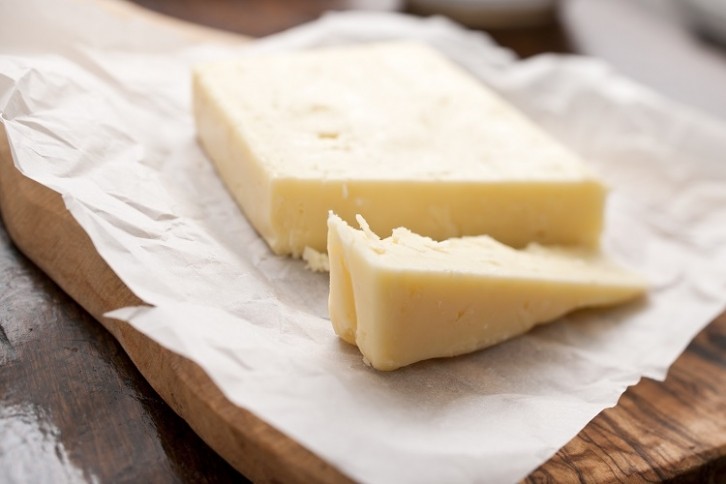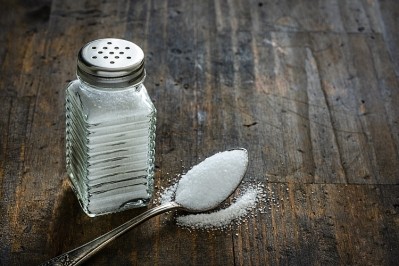Does cheese contain too much salt?

Many of us enjoy a strong, salty cheese, like a mature cheddar or a grilled halloumi. However, high salt content can be damaging for health. And cheese, according to Action on Salt, certainly has a high salt content.
According to the campaign group's new report, cheese producers are putting too much salt in their products. Action on Salt has found that 30g of cheddar contains on average more salt than a packet of crisps.
The research, which assessed 600 cheddars and similar cheeses across 10 UK retailers, found that few products showed a significant decrease in salt content over the past decade.
Voluntary salt reduction targets 'too lenient'
Dairy-based cheese didn’t come out well in the report. In particular, cheddar cheese, which according to manufacturers such as Branston and Cartwright & Butler is the UK’s favourite cheese, has on average 1.78g of salt per 100g.
This has not decreased, but in fact slightly increased over time. In 2012, for example, the average salt content in cheddar was 1.68g per 100g.

However, many of the cheeses assessed already fall below the maximum salt target set in 2020 by the UK’s Department of Health and Social Care, which asks manufacturers to reduce salt content in cheddar and hard-pressed cheese to below 1.9g per 100g, with an average salt target of 1.66g per 100g, to be achieved by the end of this year.
This, in the view of Action on Salt, is too lenient. “The target for hard-pressed cheese has remained fairly constant since the first targets were set in 2006, and based on previous data from 2012, we have seen little to no reductions in salt for this category. Despite this, many of the cheese products available today fall below the maximum salt target set to be achieved by end of 2024. The large variations in salt seen in our report make it clear that the targets are far too lenient, with scope for further reductions,” Sonia Pombo, Registered Nutritionist and Campaign Lead at Action on Salt, told FoodNavigator.
It is important to note, she pointed out, that cheese is one of the main components of the British diet, which means that it is a key source of the negative health outcomes linked to salt. “Cheese is a staple ingredient in most households, with near 8kg purchased per person each year, and is one of the main contributors of salt to our diet.
“Regularly consuming too much salt will raise our blood pressure, which is the single biggest risk factor for strokes and cardiovascular disease. Lowering salt intake reduces blood pressure in almost everyone; men and women of all ages, ethnic groups and socioeconomic status, and will therefore improve population health outcomes.”
Health affects of salt
According to the World Health Organisation (WHO), the main negative health effect of salt, stemming mainly from the sodium in it, is raised blood pressure.
This can raise the risk of a range of health conditions such as obesity, cardiovascular disease, kidney disease, osteoporosis, Meniere’s disease and gastric cancer.
An estimated 1.89mn deaths are associated each year with overconsumption of sodium.
However, trade association Dairy UK argues that salt is necessary for cheese production. “There are a number of areas where the report from Action on Salt falls short and demonstrates a lack of understanding of how cheese is made and why salt is added in the first place,” said Dr Judith Bryans, CEO of Dairy UK.
“At one point, Action on Salt cites the salt content of a mature Cheddar cheese and compares it with a mild Cheddar cheese suggesting that the difference in salt content between the two ‘proves’ that the higher salt content in the mature cheddar is unnecessary. This is nonsense.
“Vintage and mature Cheddars age for much longer than mild Cheddars. Salt performs a number of essential roles in cheese which go beyond enhancing taste: it inhibits the growth and activity of harmful organisms, it controls the breakdown of protein which is important for flavour and texture development, and it is crucial for the development of defining cheese characteristics such as colour and crust. A cheese that needs to mature for longer needs to have a higher salt content than a milder variety.
“In its report, Action on Salt recognises that many of the cheese products available today fall below the maximum salt target set in 2020 by the Department of Health and Social Care to be achieved by 2024. Yet it still calls for further reductions citing variations as it’s justification, but the variations are because it has compared a range of cheeses all of different maturity levels and with different characteristics.”
Furthermore, Dr Bryans pointed out that data from the UK’s National Diet and Nutrition survey shows that cheese accounts for 4% of sodium intake for children between the ages of four and 18, and 5% for adults between 19 and 64. Furthermore, 30g of hard cheese provides nutrients such as protein, calcium, phosphorus, B12, fat and Vitamin A.
How does plant-based fare in the salt stakes?
While dairy cheeses assessed did not come off well, plant-based cheese showed an even higher average salt content with an average 1.91g of salt per 100g - 10% saltier than animal-based cheese.
Salt content varies across plant-based cheese manufacturers, suggested Marie Dobenesque, food research, development and innovation leader at plant-based cheese manufacturer Stockeld Dreamery.
“Ultimately the level of salt is a combination of the process to make the cheese (eg maturation for old cheese or conservation in brine for feta cheese) and a conscious decision by the product developer in relation to the sensory performance of the cheese,” she told FoodNavigator. Stockeld’s own products, she said, were ‘on the low side of the competitive landscape.’
Action on Salt’s Pombo suggested that food processing could be the reason. “Plant alternatives are often developed to mimic the flavour and texture of meat counterparts, and as they are heavily processed, they often end with higher levels of salt. But much like other categories of food, the salt levels in plant-based cheese also vary from company to company (between 1.25 and 2.5g/100g), which again shows it is possible for some companies to reduce their salt content.” However, she said it was important to defer on this to food companies, who know better.
Why is cheese so salty?
Salt reduction, according to Action on Salt’s Pombo, is easy if done in increments. “Gradual reductions in the salt content of cheese, i.e. simply adding less over time, are possible and feasible, without impact to safety or quality. There is variation in salt content for plain standard cheddar across different businesses, with [UK retailer] Morrisons producing cheddar cheese that is approximately 8% lower in salt compared to many other companies. This confirms that salt reduction is indeed possible. Companies can also explore other alternatives, including lower sodium salts.” Stockeld Dreamery’s Dobenesque agreed, saying that there is ‘no magic bullet’ for salt reduction.
High salt in pizza
Another foodstuff that often has high salt content is pizza. Last year, Action on Salt revealed that one in two pizzas in the UK has more than the daily recommended amount of salt, and one has three times the daily recommended amount.
Could this lead to a reduction of profits? So far, no, Pombo claimed. “From our discussions with businesses, we are not aware of any unintended consequences or reductions in sales. When done gradually, consumers do not notice the difference, which is the best approach.”
Stockeld's Dobenesque, however, believes that salt reduction can prove a challenge. “Reducing salt content to a healthy level can be a competitive disadvantage: either the salt perception isn’t compensated and taste experience may be perceived as lower to competition with a higher salt level OR the taste experience is maintained but it likely will be at a higher recipe cost,” she told FoodNavigator.
“The only way forward is therefore a coordinated industry-wide reduction to re-condition the taste perception of consumers: a multi-year step-by-step reduction of salt with a small enough increment for consumers not to perceive the difference and enough time between recipe changes for consumers to get used to the new normal. I only know of one such example which was the margarine category in the UK in the 2000s.”























